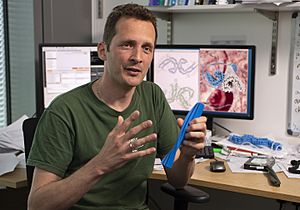Sjors Scheres facts for kids
Quick facts for kids
Sjors Scheres
|
|
|---|---|
 |
|
| Nationality | Dutch |
| Alma mater | |
| Scientific career | |
| Institutions |
|
| Thesis | Conditional Optimization: an N-particle approach to protein structure refinement (2003) |
| Doctoral advisor | Piet Gros |
Sjors Hendrik Willem Scheres (born in 1975) is a Dutch scientist. He works at the MRC Laboratory of Molecular Biology in Cambridge, UK. He is known for his important work in understanding tiny parts of living things using special microscopes.
Contents
Sjors Scheres's Education
Sjors Scheres studied Chemistry at Utrecht University in the Netherlands. During his studies, he spent nine months in France at a place called the European Synchrotron Radiation Facility. This is a big science center where scientists use powerful X-rays to study materials.
After that, he returned to Utrecht University to earn his PhD (Doctor of Philosophy) degree. His research focused on Protein Crystallography. This is a way to figure out the exact 3D shape of proteins, which are like tiny machines inside our bodies. His professor, Piet Gros, helped guide his studies.
Sjors Scheres's Career in Science
From 2003 to 2010, Sjors Scheres worked as a researcher at the Spanish National Center for Biotechnology (CNB). There, he started developing computer programs to help understand images from a special microscope called Cryogenic electron microscopy (cryo-EM). This microscope lets scientists see very tiny things, like proteins, by freezing them.
In 2010, Sjors Scheres became a group leader at the MRC Laboratory of Molecular Biology in Cambridge. He continued to improve his computer programs, especially one called RELION. This program helps scientists figure out the exact 3D shapes of proteins using cryo-EM images. In 2020, he and his team used RELION to see a protein called apo-Ferritin in amazing detail, almost down to its individual atoms!
Discovering Protein Structures
Besides making computer tools, Sjors Scheres also worked with other scientists to discover the shapes of important proteins. For example, his group helped figure out the structure of human Gamma secretase. This protein is important for how our cells work.
Since 2016, Sjors Scheres has worked closely with Michel Goedert, another scientist at the same lab. They used the cryo-EM methods developed by Scheres to study Amyloid fibrils. These are tiny, tangled clumps of proteins that can build up in the brain. They first looked at these clumps made of Tau protein from the brain of someone with Alzheimer's disease.
Since then, they have also studied other types of protein clumps linked to brain diseases. They've looked at tau protein clumps from other conditions similar to Alzheimer's. They also studied clumps of Amyloid beta (another protein linked to Alzheimer's), Alpha-synuclein from a disease called Multiple system atrophy, and TMEM106B. Understanding the shapes of these clumps helps scientists learn more about these diseases.
Leadership and Recognition
Sjors Scheres has also taken on important roles in the scientific community. Since 2014, he has been on the board of editors for a science journal called eLife. In 2018, he became a joint head of the Structural Studies Division at the MRC Laboratory of Molecular Biology.
In 2021, he was chosen as a Fellow of the Royal Society. This is a very high honor for scientists in the UK. In 2022, he was also made a foreign member of the Royal Netherlands Academy of Arts and Sciences in his home country.
Awards and Honors
Sjors Scheres has received several awards for his scientific work:
- Leeuwenhoek Lecture of the Royal Society (2022)
- Bijvoet medal of the Bijvoet Center for Biomolecular Research (2018)
- Elected EMBO Member (2017)
- Gold medal KNCV (2015)
- Named one of Nature's 10 most important people in science in 2014

